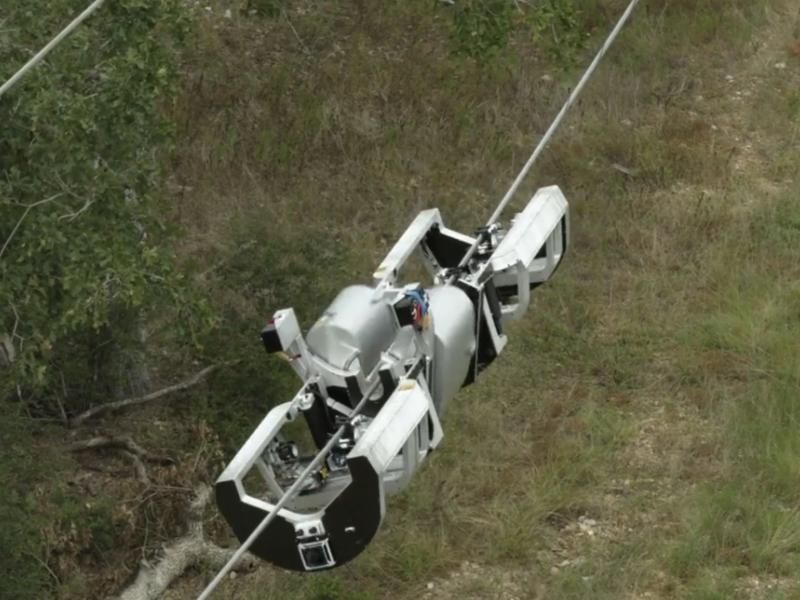The robot’s code name is Bombyx, which is Latin for silkworm, and pilot tests with the machine begin next year.
The robot rests delicately atop a power line, balanced high above the ground, almost as if it’s floating. Like a short, stocky tightrope walker, it gradually makes its way forward, leaving a string of cable in its wake. When it comes to a pole, it gracefully elevates its body to pass the roadblock and keep chugging along.
This isn’t a circus robot. Facebook developed the machine to install fiber cables on medium-voltage power lines around the globe. The aim is to make it cheaper for internet service providers to build out their networks using super-fast and reliable fiber connections. Installing fiber is a pricey endeavor, limiting where it can be deployed. If the cost of installation goes down, says Facebook, so too does the cost of service for the end user.
The social network and Mark Zuckerberg, its chief executive and founder, have long wanted to expand access to the internet. The fiber-installation robot — code-named Bombyx, which is Latin for silkworm — and a slimmer fiber-optic cable that’s housed inside the machine’s body are part of that push. The robot crawls along power lines and weaves its streamlined fiber cables around the lines already in place. It “dramatically lowers” the cost of fiber deployment by using existing electrical infrastructure, Facebook says.
The social networking giant plans to nonexclusively license the technology and will launch a pilot program with partners next year. It won’t be building the robot — which doesn’t have a set retail price — but will count on partners to manufacture and sell it.
“Half the world’s population is not connected,” said Karthik Yogeeswaran, a wireless systems engineer in Facebook’s connectivity group and the brains behind the new robot. About 80% of those people live under existing 3G or better networks but still aren’t online because they can’t afford it, he said in an interview with CNET.
“Fiber has orders of magnitude more bandwidth than basically any other technology,” Yogeeswaran said. “We want to allow abundance so that more people can get more data.”
While carriers are busy rolling out super-speedy 5G wireless service, pockets of the world still have slow internet, and 3.5 billion people have no access at all. The novel coronavirus pandemic has made the need for high-speed, broadband internet even more obvious. In some places, hospitals, schools and other critical organizations don’t have fast-enough internet to function. As people work from home, they require steady connections to get their tasks done, and kids need internet access to complete their digital coursework. Without connectivity, none of that is possible, disadvantaging people who live in places without reliable, fast internet access. Facebook wants to help, but it’ll be hard-pressed to succeed where many others have failed.
In the US, the federal and state governments have provided billions of dollars to companies to build out speedy fiber networks, but the installation is still pricey and time consuming. Digging up ground and putting fiber in can cost tens of thousands of dollars per mile to install. In emerging markets, lack of access to broadband can be even more pronounced. Even if service is available, it can be too pricey for many people to afford beyond low data-cap, pay-as-you-go plans.
“While the pandemic isn’t responsible for the digital divide, it’s exposing … the hard truth of the significance of that,” Yael Maguire, vice president of engineering for Facebook’s Connectivity Lab, said in an interview. “The pandemic is certainly unprecedented for all of us in many ways.”
While the timing of Facebook’s announcement may raise eyebrows given all of the controversy surrounding the company, it’s important to note that the social network’s mission to expand internet connectivity started long before COVID-19 ravaged the globe. The company envisions the entire world connected to the internet. It’s worked on programs like internet-beaming drones and apps that let users briefly browse text on any mobile website for free.
Facebook isn’t the only tech company working on fiber. Google, as well as traditional carriers like Verizon, have rolled out fiber but have struggled along the way. Like Google, Facebook benefits when more people are online and able to use its services, whether it’s the core social network, Instagram or messaging service WhatsApp.
Cables and robots
Three years ago, Facebook started looking at a more affordable way to deliver high-speed internet through fiber-optic cables. Yogeeswaran said the idea of using power lines to support the fiber cables came to him while he was traveling through rural Africa. Uganda was filled with medium-voltage power lines that emit between 10,000 to 35,000 volts, and he envisioned fiber installed alongside those cables.
Building a robot to install the fiber, high above the ground, made sense. While doing more research, Yogeeswaran learned about a method developed in the 1980s in which a machine would wind fiber cable around power lines.
“It never really caught on as a commercial success and that was partially because it was built using ’80s technology,” he said. “You had gas-powered motors and they kind of relied on humans moving these things across obstacles. You had to shut the power off.”
One product developed in the UK called SkyWrap winds cable around power lines in remote areas and places where it would be tough for a human to reach the poles, such as above a river.
Traditionally, workers will lash a fiber cable to a wire attached to a pole rather than wrap it around. But there’s a lot of preparation work that needs to be done beforehand to support the fiber cable. The task requires large crews of people and heavy equipment, which drives up the cost, Yogeeswaran said. Wrapping fiber cable around power lines cuts this time-consuming work because workers no longer need to make new space on the pole or pull the cable with a lot of tension so it doesn’t fall. Facebook’s approach would require two or three electric utility linemen, a pickup truck, spools of fiber cables only a few kilometers long, a robot and several other tools.
Medium-voltage power lines are also “thinner and weaker,” so Facebook had to create a lighter robot, along with slimmer fiber cable that can resist damage from high temperatures and wind but still be small enough to be wound inside the robot’s body.
Working with veteran cable designer Wayne Kachmar and other academic advisors and companies, Facebook and its partners created a fiber cable that’s 4 millimeters in diameter. A typical aerial fiber cable can be between 10 to 13 millimeters in diameter. Cable used to wrap around power lines is about 7 millimeters in diameter.
Facebook then teamed up with New York-based ULC Robotics to design a robot that can wrap a cable around a power line as it moves forward, and clear obstacles such as an insulator and other objects on the pole without the help of a human. Instead of using a round heavy spool loaded with a kilometers’ worth of cable, workers shed weight by forming the cable into a horseshoe shape and attaching it to the robot. That also makes it possible for the robot to clear obstacles by lifting up the fiber cable. As the robot passes an obstacle, it regains its balance, lowers the fiber cable and continues wrapping.
Importantly, Bombyx can safely wrap fiber around power lines that carry electricity, something that’s difficult for humans to do. There’s no need to cut power service to customers served by the line to install fiber using the robot. And it can install more than a kilometer of fiber in about an hour and a half.
Still, there’s more work to be done before Facebook and its partners launch a pilot project. That includes making sure the robot can get the job done without requiring an engineer to oversee its work, working with electric companies and creating safe operating procedures.
Fiber’s price tag
Today, millions of Americans lack broadband internet, defined as download speeds of 25 megabits per second and upload speeds of 3 mbps. The latest estimate from the US Federal Communications Commission says 18 million Americans, or roughly 5.6% of the population, go without fast connections. But certain segments are hit even harder. About 30% of people in rural areas lack broadband, as do 40% of the nation’s schools and 60% of health care facilities outside major metropolitan areas.
US federal and state officials have made nationwide broadband access a priority, offering grants and other incentives to big internet service providers and small-town telephone companies to upgrade their networks. In February, the FCC approved a $20 billion fund to ensure that residents in rural areas of the US have access to broadband internet connections. But differing opinions exist about how best to deploy those funds, and outdated maps with insufficient detail make it tough to determine where the true need really is.
The situation in developing nations is even worse, with wide swaths of countries having little or no connectivity.
Fiber-optic lines typically are the best solution for spreading high-speed internet. Even 5G networks, which are being turned on around the globe, rely on fiber as their backbone. Fiber can deliver gigabit speeds and is more reliable than wireless connections. The preferred way to deliver such high speeds to users is to build fiber straight to their homes. But that gets expensive fast.
A decade ago, many companies turned to fiber as the way to deliver internet to their customers. In 2010, Google launched its big push with fiber, promising to deliver service more than 100 times faster than what most Americans could access. ISPs in cities Google served lowered their prices and boosted speeds to compete. But in an illustration of the cost and difficulty of deploying fiber, Google in 2016 “paused” plans to roll out its internet service to new cities to explore other wireless options. Verizon also stopped rolling out its Fios fiber-optic internet service, which likewise connected to individual houses.













![Hotstar Premium Cookies 2019 [*100% Working & Daily Updated*] Hotstar Premium Cookies 2019 [*100% Working & Daily Updated*]](https://tahav.com/wp-content/uploads/2019/11/Hotstar-Premium-Cookies-Free-100x70.jpg)



